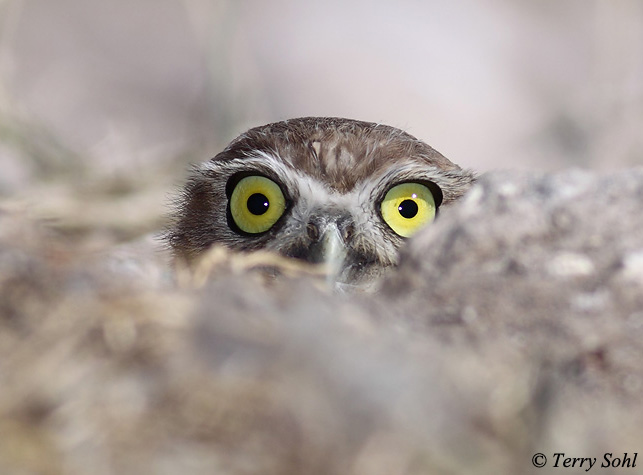| Return to Main Page | Dakota Birder Blog | Follow @DakotaBirder |
![]()
 Burrowing
Owl
Burrowing
OwlWhen people think of using flash for photography, they usually think of lighting up dark situations, such as taking photos of people indoors. But flash for bird photography? During the day? A SUNNY, bright day close to high-noon? Why on earth would a bird photographer use flash in that situation?
In 2009 I was on a business trip in Park City, Utah, but had some time to kill and decided to head towards Antelope Island, a place where a Utah birding contact had told me was a great place to bird. I was mainly after shorebirds along the lake, as well as some of the western birds on the island itself (particularly I wanted to see and photograph a Sage Thrasher). As I'd never been in the area before, I didn't know what other birds to expect. I was thus surprised that as I drove down the long causeway road that links to the island, I saw a group of three Burrowing Owls.
We have Burrowing Owls in South Dakota, but they are one of those species that you just can't help but watch (and photograph) when you get the chance. The birds were hanging out around the rocky rip-rap that lined the banks of the causeway, and when I would get close, they'd duck into a gap and hide. Challenge number 1...how could I get close enough to get a photo?
As you'll sense is a common theme for a lot of my photography, I used my car as a blind. The owls wouldn't let me approach on foot without flushing or hiding, so I got back in my car, slowly pulled over off the side of the road where one was hiding amongst the rocks, and waited. As per usual, it wasn't long before the birds forgot that there might be an actual human being inside the car. The owl was cautious however, slowly poking his head out of a gap in the rocks, looking around, ducking back down, etc.
The bird was there and in position to be photographed, and I thought it would be great to get a photo of him peeking out of the hole in the rocks. Challenge number 2...there was VERY bright mid-day sun that was illuminating the owl from the side. Taking an initial photo of the bird, it was obvious that the bright sun was causing too much contrast between the shaded and lit side of the owl. The side of the face towards the sun was wonderfully illuminated, but the harsh light made the other side of the face appear as a dark shadow. The lighting situation is obvious when you look at the owl's eyes. The owl's pupil on the right side of the image is much smaller (in the sun) than the pupil on the left side (wider to let in more light on the shaded side). With such a harsh lighting situation, how do you balance out the lighting?
Fill-flash! Yes, using flash can be a WONDERFUL tool on sunny days, as it can help to even out the lighting and reduce shadows. The problem with bird photography however is that you're typically using long lenses and the subject is usually some distance from the camera. Given these factors, "normal" flash won't work, as it won't have the reach to illuminate a bird that's more than several yards from the camera. Bird photographers generally rely heavily on tools such as the "Better Beamer" that I use. A Better Beamer is a simple gadget that attaches to your external flash unit. It has a "Fresnel screen" that is placed in front of the flash, a screen that concentrates the light from the flash and projects in a (narrower) beam for a longer distance than your flash could cover by itself.
I almost always have my flash and Better Beamer along, and this was the perfect situation to use it. The key is that you have to set the camera and flash to use the flash as complimentary lighting, not the primary lighting. I set the flash to provide fill-flash (complimentary lighting, not primary), and set the flash-exposure compensation (FEC) to - 1 1/3rd. Using fill flash can be very straightforward, and after talking to other folks for recommended settings, it seemed setting FEC somewhere between -1 and -2 could cover most fill-flash situations.
There simply wasn't any comparison between the "flashed" photos and the initial, un-flashed photos. Instead of a photo that showed an owl brightly illuminated on one side and darkly shadowed on the other, the light was evened out much more. I was thrilled with the resulting shot, showing the owl peeking out of its hiding place in the ground. A perfect way to represent a burrowing owl, all thanks to the power of fill-flash!!
| Camera Body: | Canon 50D | |
| Camera Lens: | Canon 400mm 5.6L | |
| ISO: | 100 | |
| Aperture: | f/6.3 | |
| Shutter Speed: | 1/1000th | |
| Flash: | Fill Flash (-1 1/3rd), Better Beamer | |
| Support: | Camera resting on car window frame | |
| Date: | 07/27/2009 | |
| Location: | Antelope Island, Utah |
All photos copyrighted! Click for information on commerical usage, or usage for other personal purposes.
Use the following Google dialogue to search this South Dakota Birds and Birding site:

Custom Search
|
SOUTH DAKOTA BIRDS AND BIRDING - LOCATIONS OF WEBSITE VISITORS
Please mail any comments/suggestions/additional links for this page to: Terry L. Sohl